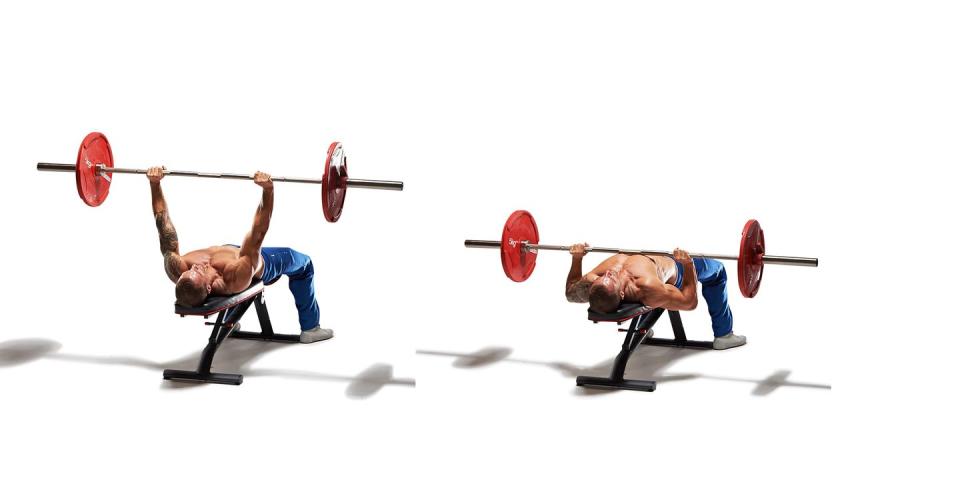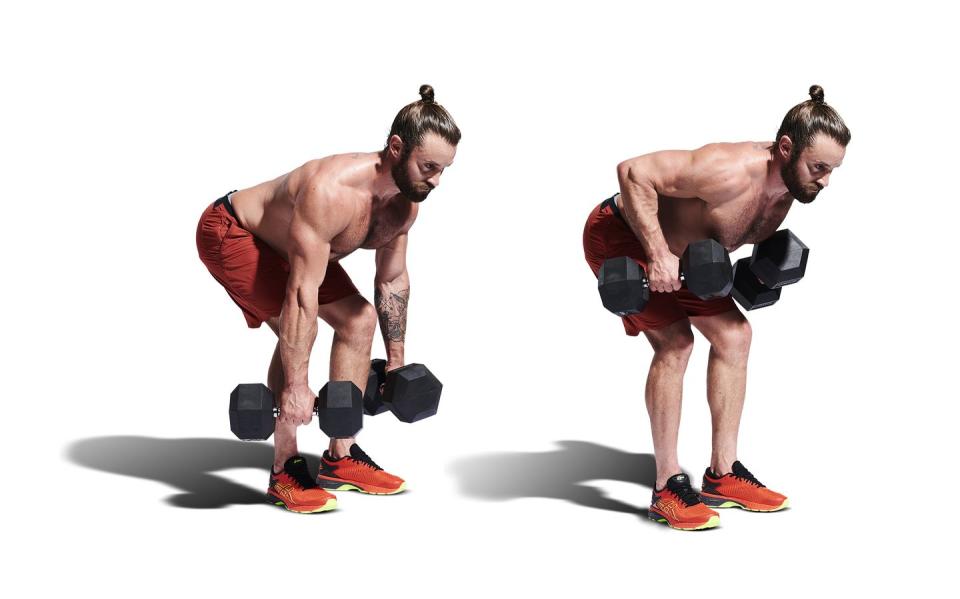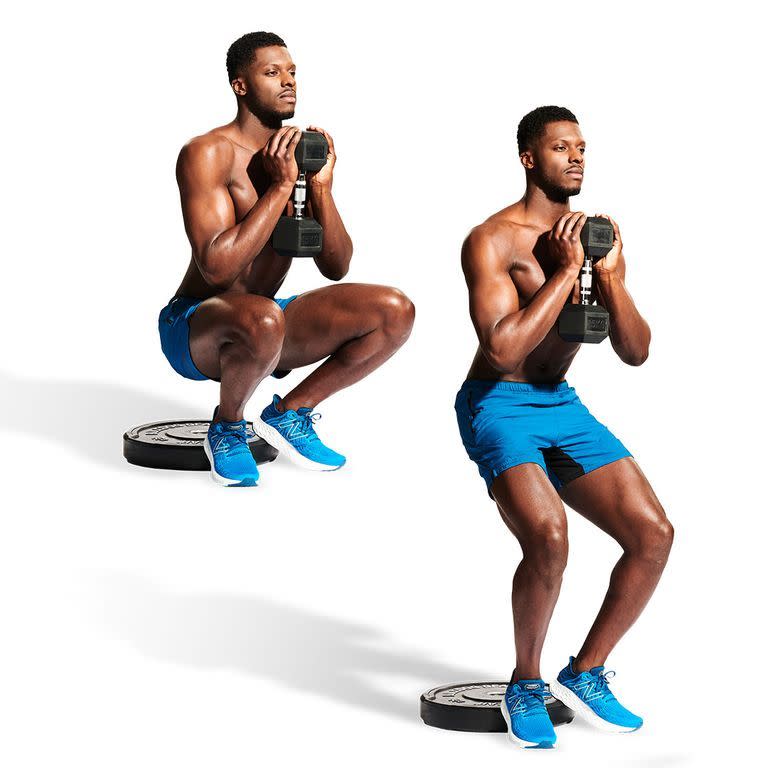The '6-12-25 Shock Method' Leads to a Massive Pump and Fast Muscle Growth
The name may sound a little technical, but the 6-12-25 method is simple and savage. The protocol has been popular among bodybuilders and CrossFitters for many years – no doubt due to the huge pump and quick gains it promises to deliver. Now, due to its reported muscle-building effects being shared on social media, the wider gym-going world wants in on the protocol.
The 6-12-25 method utilises a giant-set style of training, working as a heavy hitting trifecta for hypertrophy (muscle building). But it's important to get it right. Perform it incorrectly and you could be leaving gains on the table.
Thankfully, this complete guide should set you on your way to a huge hypertrophic pump.
What is the 6-12-25 Protocol?
The 6-12-25 protocol was originally created by the late Canadian strength coach Charles Poliquin. The protocol uses giant sets – or tri-sets – with minimal rest to get a high volume of work done in a short amount of time. It's really important to choose the right exercises for the sets in order for it to work optimally and the way it was designed to.
It typically focusses on one muscle group per set with three different exercises. There is minimal rest between exercises as they are performed in succession at six, 12 and 25-rep ranges. There is usually three-to-five sets and at least three minutes rest between them.
What Does a Set Using the 6-12-25 Protocol Look Like?
3-5 sets can be completed of:
First exercise: 6 reps and rest 10 seconds
Heavier loads, typically using compound exercises.
Second exercise: 12 reps and rest 10 seconds
Moderate loads, typically using accessory or isolation exercises.
Third exercise: 25 reps and rest 3 minutes
Lighter loads, typically using accessory or isolation exercises.

What Are the Benefits of the 6-12-25 Protocol?
Enhanced Hypertrophy
According to an article published in the Journal of Strength & Conditioning Research the key components of hypertrophy are mechanical tension, muscle damage and metabolic stress, and the 6-12-25 protocol is efficient at hitting all three. You'll be able to increase volume and therefore make your chance at muscle building far more likely.
Increased Strength
The focus on lower-rep ranges and heavier weights at the beginning of sets can improve muscular strength. You can reap the rewards of muscle gains and strength all in one with the protocol by focussing on compound moves at the beginning of your sets, therefore helping you push through plateaus and see your strength numbers shoot up.
Improved Muscular Endurance & 'The Pump'
Working to higher-rep ranges means that you will be pushing your muscular endurance and increasing blood flow to the muscles. Higher rep ranges increase capillary density, ensuring your muscles get used to sustained activity without hitting fatigue. Aside from the science, the increased blood flow and fluid accumulation results in that sought after pump.
Reduced Time
Crucially, for those with busy schedules, the 6-12-25 method could be your time saving solution. By completing all exercises in succession with minimal rest, you will be cutting down on your gym time and getting in just as much volume. More gains, less time wasted.
6-12-25 Protocol Workout
Now you know why to try the 6-12-25 protocol, here's your chance to try the three-day split, or if you want a mammoth session, all three on the same day.
Chest
3-5 sets / 3 minutes rest

Bench Press x 6 reps / 10 seconds rest
Lay flat on a bench, with your knees bent and pushing your feet into the floor. Take the weight off the rack, locking out your elbows. Lower the bar slowly until it touches your chest. Keep your elbows at a 45-degree angle, pause here before explosively pressing back up.

Incline Dumbbell Chest Press x 12 reps / 10 seconds rest
Sit at the end of the bench set at a 30-45° incline with the dumbbells on your knees. Lean back on the bench and lift the dumbbells over the chest. Have your feet planted on the floor, core engaged and arms locked out with the dumbbells directly above the upper chest. Slowly lower the elbows into an arrow shape just below your shoulders so that you get a big stretch. Pause for a second before pushing the weights explosively away from you, back to your starting position as you exhale, ready to repeat.

Incline Dumbbell Chest Fly x 25 reps / 3 minutes rest
Take some lighter weights and lean back on the bench with the dumbbells above your chest. With the palms facing inwards, keep a slight bend at the elbow as you lower the dumbbells either side of you. Feel a stretch across the chest and bring the dumbbells back together, squeeze the pecs and repeat.
Back
3-5 sets / 3 minutes rest

Weighted Pull-ups x 6 reps / 10 seconds rest
Complete weighted, bodyweight or band assisted depending on ability. Ideally at six reps you should be a couple of reps away from failure or nearing it. Grab a pull-up bar with an overhand grip, with you hands over shoulder-width apart. Lift your feet from the floor, hanging freely with straight arms. Pull yourself up by flexing the elbows, while pinching your shoulder blades together. When your chin passes the bar, pause before lowering to the starting position.

Bent-over Dumbbell Row x 12 reps / 10 seconds rest
With your dumbbells hanging at your sides, have your legs slightly bent, lock your core, keep your back straight and send your hips behind your heels so that your torso is almost perpendicular to the floor. Row the dumbbells upwards in an arc shape towards your hips. Pause and squeeze the shoulder blades together for a beat while keeping the shoulders away from the ears. Slowly reverse the rep back to the beginning position.

Face Pull x 25 reps / 3 minutes rest
Set the rope attachment above eyeline and begin standing or kneeling in front of it. Grab the handles with an overhand grip, thumbs towards your face and pull them towards you. The rope should split either side of your head. Keep the elbows at shoulder height or slightly higher. Pause, then reverse the movement.
Lower Body
3-5 sets / 3 minutes rest

Back Squats x 6 reps / 10 seconds rest
Begin by grabbing the barbell a little wider than shoulder-width apart. Unrack the barbell with it on the meaty part of your shoulders, behind your head. Maintain an upright torso and push your hips back, bending your knees until your thighs pass parallel to the floor. Stand back up to the start position.

Dumbbell Romanian Deadlift x 12 reps / 10 seconds rest
Start standing tall with your feet underneath your hips. Hold your dumbbells in front of your thighs. Send your hips behind your heels with a flat back as if you're shutting a car door with your backside. Keep the knees directly above your heels and shins vertical to the floor. Keep your shoulder blades drawn towards each other and head in line. Feel a stretch in your hamstrings and when the dumbbells are below your knees, send your hips forward to return to the starting position.

Goblet Cyclist Squats x 25 reps / 3 minutes rest
Raise your heels up on a weight plate or block, keeping your feet within six inches of each other, heels close together. Hold your dumbbell close to your chest. Squat down until your thighs pass parallel to the ground, stand up explosively, stopping just short of locking your legs out to keep the tension on the quads. Repeat.
The Best Workout Methods for Building Muscle
While the 6-12-25 method is a potent stimulus for hypertrophy, you can also see tremendous benefit from following these other training protocols:
Use 'Cluster Sets' to Push Through Plateaus, Maximise Strength & Hypertrophy Gains
The Men's Health Dumbbell Club 150+ Muscle Building Dumbbell Only Workouts
Use This Resistance Band and Bodyweight Finisher for a Brutal Biceps and Triceps Pump
Use the 'Repeat and Beat' Method to Guarantee Strength and Size
The Hepburn Method Is the Ultimate Powerbuilding Tool for Building Strength and Size
Hit a Training Plateau? Reverse Pyramid Sets are The Key to Bigger Gains
How To Use The Contrast Training Method To Build Explosive Size, Speed and Power
The 'E2MOM' Method Adds Serious Strength and Size Every Week
How to Use The 5/3/1 Powerlifting Method for Massive Lifts and Huge Strength Gains
You Might Also Like


